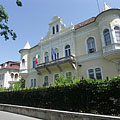(小さな画面のデバイス用に最適化)
Elizabeth Bridge ("Erzsébet híd") - ブダペスト, ハンガリー
クリックした後:
写真をクリック
-
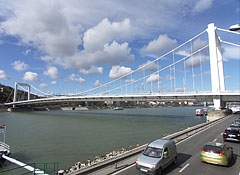
The slender Elisabeth Bridge over River Danube
撮影の日付:20132013
作成者:Robert Németh
カメラモデル:Konica Minolta Dimage A200
ブダペスト, ハンガリー
-
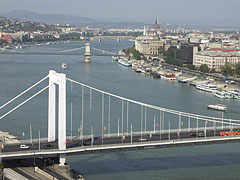
The inner Dabube-bridges from the Gellért Hill
撮影の日付:20112011
作成者:Robert Németh
カメラモデル:Konica Minolta Dimage A200
ブダペスト, ハンガリー
-
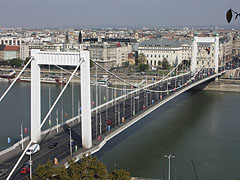
The slender Elisabeth Bridge from the Gellért Hill
撮影の日付:20112011
作成者:Robert Németh
カメラモデル:Konica Minolta Dimage A200
ブダペスト, ハンガリー
-

The eastern (Pest-side) pylon of the pure white Elisabeth Bridge
撮影の日付:20132013
作成者:Robert Németh
カメラモデル:Konica Minolta Dimage A200
ブダペスト, ハンガリー
-
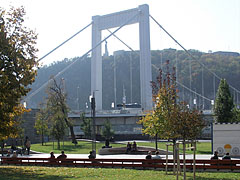
The Elizabeth Bridge and the Gellért Hill from the renovated Március 15. Square
撮影の日付:20132013
作成者:Robert Németh
カメラモデル:Konica Minolta Dimage A200
ブダペスト, ハンガリー
-
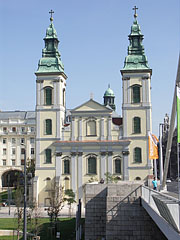
The Inner City Parish Church from the Elisabeth Bridge
撮影の日付:20112011
作成者:Robert Németh
カメラモデル:Konica Minolta Dimage A200
ブダペスト, ハンガリー
-
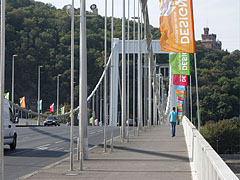
The Elisabeth Bridge and the Gellért Hill
撮影の日付:20112011
作成者:Robert Németh
カメラモデル:Konica Minolta Dimage A200
ブダペスト, ハンガリー
-
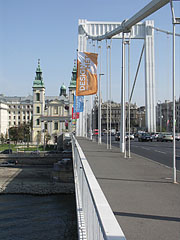
Looking at Pest from the Elizabeth Bridge
撮影の日付:20112011
作成者:Robert Németh
カメラモデル:Konica Minolta Dimage A200
ブダペスト, ハンガリー
-
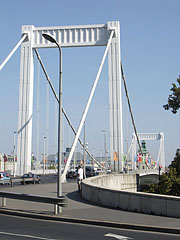
The Elisabeth Bridge from Buda
撮影の日付:20112011
作成者:Robert Németh
カメラモデル:Konica Minolta Dimage A200
ブダペスト, ハンガリー
-
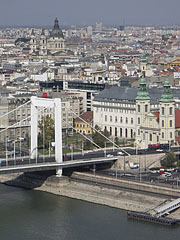
The Elisabeth Bridge from the Gellért Hill
撮影の日付:20112011
作成者:Robert Németh
カメラモデル:Konica Minolta Dimage A200
ブダペスト, ハンガリー
-
The Pest-side pylon of the Elisabeth Bridge
撮影の日付:20112011
作成者:Robert Németh
カメラモデル:Konica Minolta Dimage A200
ブダペスト, ハンガリー
The Pest-side pylon of the Elisabeth Bridge - ブダペスト, ハンガリー -
The white pylon and cables of the Elisabeth Bridge
撮影の日付:20112011
作成者:Robert Németh
カメラモデル:Konica Minolta Dimage A200
ブダペスト, ハンガリー
The white pylon and cables of the Elisabeth Bridge - ブダペスト, ハンガリー -
The white pylon of the Elisabeth Bridge
撮影の日付:20112011
作成者:Robert Németh
カメラモデル:Konica Minolta Dimage A200
ブダペスト, ハンガリー
The white pylon of the Elisabeth Bridge - ブダペスト, ハンガリー -
The pillar of the Elisabeth Bridge on the Pest-side riverbank of the Danube
撮影の日付:20132013
作成者:Robert Németh
カメラモデル:Konica Minolta Dimage A200
ブダペスト, ハンガリー
The pillar of the Elisabeth Bridge on the Pest-side riverbank of the Danube - ブダペスト, ハンガリー -
The Buda end of the Elizabeth Bridge, as well as the Statue of St. Gerard (in Hungarian "Szent Gellért") on the Gellért Hill
撮影の日付:20132013
作成者:Robert Németh
カメラモデル:Konica Minolta Dimage A200
ブダペスト, ハンガリー
The Buda end of the Elizabeth Bridge, as well as the Statue of St. Gerard (in Hungarian "Szent Gellért") on the Gellért Hill - ブダペスト, ハンガリー -
The Elisabeth Bridge viewed from Pest
撮影の日付:20132013
作成者:Robert Németh
カメラモデル:Konica Minolta Dimage A200
ブダペスト, ハンガリー
The Elisabeth Bridge viewed from Pest - ブダペスト, ハンガリー -
The Elisabeth Bridge vieved from the Belgrád Quay (Pest-side embankment), as well as the Buda Palace in the background
撮影の日付:20132013
作成者:Robert Németh
カメラモデル:Konica Minolta Dimage A200
ブダペスト, ハンガリー
The Elisabeth Bridge vieved from the Belgrád Quay (Pest-side embankment), as well as the Buda Palace in the background - ブダペスト, ハンガリー -
Tram tracks on the Pest-side embankment, as well as the Elisabeth Bridge and the Matthias Church (the latter in Buda) in the background
撮影の日付:20132013
作成者:Robert Németh
カメラモデル:Konica Minolta Dimage A200
ブダペスト, ハンガリー
Tram tracks on the Pest-side embankment, as well as the Elisabeth Bridge and the Matthias Church (the latter in Buda) in the background - ブダペスト, ハンガリー -
The Danube River, the Elizabeth Bridge and the Buda Castle, viewed from the Liberty Bridge
撮影の日付:20132013
作成者:Robert Németh
カメラモデル:Konica Minolta Dimage A200
ブダペスト, ハンガリー
The Danube River, the Elizabeth Bridge and the Buda Castle, viewed from the Liberty Bridge - ブダペスト, ハンガリー -
The view of the Elisabeth Bridge over River Danube and the Buda Castle from the Liberty Bridge
撮影の日付:20132013
作成者:Robert Németh
カメラモデル:Konica Minolta Dimage A200
ブダペスト, ハンガリー
The view of the Elisabeth Bridge over River Danube and the Buda Castle from the Liberty Bridge - ブダペスト, ハンガリー -
The Elisabeth Bridge (or Elizabeth Bridge) and the spring flooding of Danube River, viewed from the Gellért Hill
撮影の日付:20062006
作成者:Robert Németh
カメラモデル:Konica Minolta Dimage A200
ブダペスト, ハンガリー
The Elisabeth Bridge (or Elizabeth Bridge) and the spring flooding of Danube River, viewed from the Gellért Hill - ブダペスト, ハンガリー -
Car traffic on the Elisabeth Bridge
撮影の日付:20062006
作成者:Robert Németh
カメラモデル:Konica Minolta Dimage A200
ブダペスト, ハンガリー
Car traffic on the Elisabeth Bridge - ブダペスト, ハンガリー -
The roadway of Elisabeth Bridge
撮影の日付:20062006
作成者:Robert Németh
カメラモデル:Konica Minolta Dimage A200
ブダペスト, ハンガリー
The roadway of Elisabeth Bridge - ブダペスト, ハンガリー -
Elisabeth Bridge from the hillside og the Gellért Hill
撮影の日付:20062006
作成者:Robert Németh
カメラモデル:Konica Minolta Dimage A200
ブダペスト, ハンガリー
Elisabeth Bridge from the hillside og the Gellért Hill - ブダペスト, ハンガリー -
Elisabeth Bridge (or Elizabeth Bridge)
撮影の日付:20062006
作成者:Robert Németh
カメラモデル:Konica Minolta Dimage A200
ブダペスト, ハンガリー
Elisabeth Bridge (or Elizabeth Bridge) - ブダペスト, ハンガリー -
The Buda end of the Elisabeth Bridge during a river flood, and the Buda Royal Palace is in the background
撮影の日付:20062006
作成者:Robert Németh
カメラモデル:Konica Minolta Dimage A200
ブダペスト, ハンガリー
The Buda end of the Elisabeth Bridge during a river flood, and the Buda Royal Palace is in the background - ブダペスト, ハンガリー -
The Downtown Parish Church of Budapest is waiting to be renovated (and the traffic on the Elisabeth Bridge can be seen)
撮影の日付:20062006
作成者:Robert Németh
カメラモデル:Konica Minolta Dimage A200
ブダペスト, ハンガリー
The Downtown Parish Church of Budapest is waiting to be renovated (and the traffic on the Elisabeth Bridge can be seen) - ブダペスト, ハンガリー -
Looking at Pest from the Elisabeth Bridge
撮影の日付:20062006
作成者:Robert Németh
カメラモデル:Konica Minolta Dimage A200
ブダペスト, ハンガリー
Looking at Pest from the Elisabeth Bridge - ブダペスト, ハンガリー -
The Elisabeth Bridge and the Ferenciek tere (in English "Square of the Franciscans"), viewed from the Gellért Hill
撮影の日付:20062006
作成者:Robert Németh
カメラモデル:Konica Minolta Dimage A200
ブダペスト, ハンガリー
The Elisabeth Bridge and the Ferenciek tere (in English "Square of the Franciscans"), viewed from the Gellért Hill - ブダペスト, ハンガリー -
A large sycamore tree (or plane tree) at the Buda-side head of the Elisabeth Bridge
撮影の日付:20062006
作成者:Robert Németh
カメラモデル:Konica Minolta Dimage A200
ブダペスト, ハンガリー
A large sycamore tree (or plane tree) at the Buda-side head of the Elisabeth Bridge - ブダペスト, ハンガリー -
The view of the Elisabeth Bridge from the Buda banks of River Danube
撮影の日付:20042004
作成者:Robert Németh
カメラモデル:Canon PowerShot A85
ブダペスト, ハンガリー
The view of the Elisabeth Bridge from the Buda banks of River Danube - ブダペスト, ハンガリー -
Elisabeth Bridge viewed from Buda
撮影の日付:20042004
作成者:Robert Németh
カメラモデル:Canon PowerShot A85
ブダペスト, ハンガリー
Elisabeth Bridge viewed from Buda - ブダペスト, ハンガリー -
The founders' plaque of the first Elisabeth Bridge
撮影の日付:20112011
作成者:Robert Németh
カメラモデル:Konica Minolta Dimage A200
ブダペスト, ハンガリー
The founders' plaque of the first Elisabeth Bridge - ブダペスト, ハンガリー -
A stone sculpture that represents an eagle; originally it was set up on the abutment of the first Elisabeth Bridge
撮影の日付:20112011
作成者:Robert Németh
カメラモデル:Konica Minolta Dimage A200
ブダペスト, ハンガリー
A stone sculpture that represents an eagle; originally it was set up on the abutment of the first Elisabeth Bridge - ブダペスト, ハンガリー -
Few remains of the first Elisabeth Bridge, which was blown up in the Second World War
撮影の日付:20112011
作成者:Robert Németh
カメラモデル:Konica Minolta Dimage A200
ブダペスト, ハンガリー
Few remains of the first Elisabeth Bridge, which was blown up in the Second World War - ブダペスト, ハンガリー -
Remains of the Buda-side abutment of the old Elisabeth Bridge, which was blown up in the World War II
ブダペスト, ハンガリー
Remains of the Buda-side abutment of the old Elisabeth Bridge, which was blown up in the World War II - ブダペスト, ハンガリー -
Park with a fountain at the Buda-side foot of the old Elisabeth Bridge
ブダペスト, ハンガリー
Park with a fountain at the Buda-side foot of the old Elisabeth Bridge - ブダペスト, ハンガリー -
The still standing Pest-side pylon of the old Elisabeth Bridge, which was blown up by the Germans
ブダペスト, ハンガリー
The still standing Pest-side pylon of the old Elisabeth Bridge, which was blown up by the Germans - ブダペスト, ハンガリー -
The original Elisabeth Bridge on an old picture postcard
撮影の日付:19071907
ブダペスト, ハンガリー
The original Elisabeth Bridge on an old picture postcard - ブダペスト, ハンガリー -
Trams on the first Elisabeth Bridge, viewed from the Gellért Hill in Buda
ブダペスト, ハンガリー
Trams on the first Elisabeth Bridge, viewed from the Gellért Hill in Buda - ブダペスト, ハンガリー -
The original Elizabeth Bridge with trams on it, viewed from the Gellért Hill in Buda
ブダペスト, ハンガリー
The original Elizabeth Bridge with trams on it, viewed from the Gellért Hill in Buda - ブダペスト, ハンガリー -
The old (first) Elisabeth Bridge
ブダペスト, ハンガリー
The old (first) Elisabeth Bridge - ブダペスト, ハンガリー -
The former word record holder old Elisabeth Bridge over the Danube River
撮影の日付:19031903
ブダペスト, ハンガリー
The former word record holder old Elisabeth Bridge over the Danube River - ブダペスト, ハンガリー -
The scaffolded first Elisabeth Bridge under the construction
撮影の日付:19001900
ブダペスト, ハンガリー
The scaffolded first Elisabeth Bridge under the construction - ブダペスト, ハンガリー -
The construction of the new (second) Elisabeth Bridge
ブダペスト, ハンガリー
The construction of the new (second) Elisabeth Bridge - ブダペスト, ハンガリー
写真をクリック
特性、特徴
位置:
GPS座標: の緯度 47°29'27"、の経度 19°2'56" (N47 29.45 - E19 2.93)
情報、短編、興味深い事実
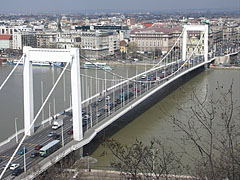 The Elisabeth Bridge (or Elizabeth Bridge) and the spring flooding of Danube River, viewed from the Gellért Hill
The Elisabeth Bridge (or Elizabeth Bridge) and the spring flooding of Danube River, viewed from the Gellért Hill
The name of the bridge is a tribute to the Bavarian-born empress Elisabeth of Austria (1837-1898) queen of Hungary and nicknamed Sisi, who was assassinated in Geneva, Switzerland. It was in important restriction in the design contest of the Elisabeth Bridge, that it should be constructed of domestic materials and by using domestic manpower. This is why the chain suspension bridge structure was chosen instead of the cable suspension bridge. Finally the bridge was built up by the plans of albert Czekelius and Antal Kherndl, it was inaugurated in 1903. At that time it was a unique, unrivalled technical wonder, until 1926 it had the longest (290-meter) span among the suspension bridges without river piers in the whole world. On both sides of the bridge there were tram tracks beside the pavements.
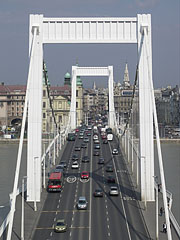 Car traffic on the Elisabeth Bridge
Car traffic on the Elisabeth Bridge
At the end of the World War II this bridge couldn't escape its fate, during their retreat the German army blew it up. The damages were completely irreparable. The Pest-side pylon was remained standing, this was the memento of the war destruction until 1960, when the new bridge was started to built. Further curiosity related to this is that although the northern suspension chain was damaged after the explosion, it was not torn.
Among the Danube bridges of Budapest the Elisabeth Bridge was the latest restored. The modern, contemporary look new cable suspension bridge was designed by architect Pál Sávoly, this new structure reused the piers of the original bridge. The rebuilding was started in 1961 and the new Elisabeth Bridge was opened for service in November 1964. In 1972 when the metro line 2 was completed the tram traffic on the bridge was terminated.
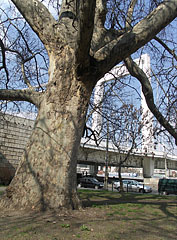 A large sycamore tree (or plane tree) at the Buda-side head of the Elisabeth Bridge
A large sycamore tree (or plane tree) at the Buda-side head of the Elisabeth Bridge
The thick-trunked plane tree at the Buda-side abutment of the Elisabeth Bridge was already stood there during the construction of the first Elisabeth Bridge, between 1898 and 1903, however just as a young tree or sapling. Then it was survived almost everything, the explosion of the old bridge (1945), then the demolution / disassembly, and the building of the new bridge as well (1961-1964). Nobody knows what accidents were needed to escape, but fortunately we can still watch and admire this tree today, at the foot of the Elisabeth Bridge on the Buda-side riverbank in a park.
ブダペスト, ハンガリー - もっとフォトギャラリー:
また、に興味があるかもしれません(関連ページ):
旅行ガイドの目的地:
ブダペスト(8,468の写真 + 21のパノラマ画像)
Buda Hills (Budai-hegység)(8,632の写真 + 21のパノラマ画像)
Pest megye (county)(15,122の写真 + 50のパノラマ画像)
ブダペストとその周辺(15,989の写真 + 52のパノラマ画像)
ハンガリー(27,287の写真 + 163のパノラマ画像)
そしてさらに:
(ここで内側:Buda Hills)
Budakeszi(88の写真)
Pilisszentiván(76の写真)
ここにすべてのパノラマ写真:
ブダペスト(21の写真)
Pest megye (county)(50の写真)
ブダペストとその周辺(52の写真)
ハンガリー(163の写真)
ヨーロッパ(165の写真)
ここにすべての通常の写真:
ブダペスト(8,468の写真 / 122のギャラリー)
Buda Hills (Budai-hegység)(8,632の写真 / 124のギャラリー)
Pest megye (county)(15,122の写真 / 221のギャラリー)
ブダペストとその周辺(15,989の写真 / 234のギャラリー)
ハンガリー(27,287の写真 / 462のギャラリー)
ヨーロッパ(30,494の写真 / 523のギャラリー)
あなたの友人と共有して下さい!
等
私達について - 法的事項および & 免責事項 -
すべての権利を保有
- ©2010-2022
Neuronit Creative Studio - Mogyoród / ブダペスト / ハンガリー





